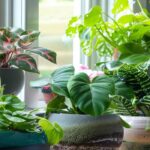By JULIE BAWDEN-DAVIS
The Orange County Register Have you ever sat in a hotel lobby surrounded by lush plants and wished you could have your own indoor garden paradise? If so, it’s time to call a plantscaper.Just as some breathtaking outdoor gardens are planted and maintained by professionals, there are stunning indoor gardens installed and cared for by trained interior landscapers.
“Many people are surprised to discover how big the interior landscaping industry is,” said Julie Davis Farrow, co-owner with her husband, Mark, of Irvine-based Plantscapers Inc. The company maintains hundreds of residential and commercial indoor gardens throughout Orange County.
The industry even has its own term for creating green spaces inside – interiorscaping.
“Interiorscaping is a billion-dollar business that’s just starting to come into its own,” said Farrow, who opened her company in 1981. “Interior landscaping has grown alongside the interior-design industry, and we often work closely with them. Interior plants used to be an afterthought, but now architects and designers are planning for indoor gardens.”
Some of the requests go beyond greenery. “One client wanted her home to look like the Mirage (casino) in Las Vegas,” she said. “So her architect created a home design that included planters. He specified and had built-in planters installed throughout the home, including under a winding staircase and all around the den. We installed 10- to 12-foot preserved Washingtonia palms and fan palms as large specimens and filled the base of the planters with small, tropical greenery such as bird of paradise, Chinese evergreen, peace lily and a vast array of colorful bromeliads.”
Professional interiorscapers consult with homeowners and their interior designers to create indoor gardens that complement home design and the personal tastes of the owners. These indoor-garden experts then install and maintain the gardens.
Jeana Keough of Coto de Caza began using interiorscapers five years ago after seeing how plants light up a house.
“Besides the fact that houseplants clean the air, I really like how they make a home warm and cozy,” said Keough, who has more than 25 plants throughout her home. “I’m in real estate and we routinely have interiorscapers decorate homes for sale. As soon as the plants are installed, the homes sell.”
Like many homeowners, Keough, although she enjoys having houseplants brighten her interior, has difficulty keeping them healthy. “I tried to take care of my indoor garden myself, but many of them died,” she said. “I find it best to have professionals maintain them for me.”
NO-FUSS INDOOR GARDEN
Hire an interior landscaper and you get a hassle-free, foolproof way to beautify your home with houseplants, said Farrow, whose company provides full plant service. That includes evaluating light levels, assisting in selecting plants and containers, installation and maintenance. They guarantee all plants and containers.
“Plantscaping is an easy, cost-effective way to enhance the look of your interior,” said Farrow. “Our average high-end home costs anywhere from $5,000 to $10,000 for the installation, and the monthly maintenance fee runs from $150 to $700, depending on the number of plants and their value.
“It’s impressive to have a home with an eye-catching, well-designed indoor garden. A good interior landscaper will evaluate your home’s architecture and style and consider that when suggesting plants and containers. Many of our clients also travel frequently, and they’re relieved to know that someone will be taking care of their plants.”
As we spend more and more time improving our homes and enjoying them, plantscaping will continue to grow in popularity, said Karin Senneff, whose company, Plant Interscapes of San Antonio, Texas, is one of the largest plantscaping companies in the nation. “For aesthetic and health reasons, homeowners increasingly want to bring the outdoors in. Not only do indoor plants make the home look great, they clean the air, reduce stress and improve productivity.”
ROOTS OF THE INDUSTRY
Considering that today’s top interiorscapers are trained in horticulture and interior design, it’s interesting to note the industry’s humble beginnings. Many early houseplant suppliers had a background in farming and traveled the country selling houseplants to small plant shops.
“Customers would walk into those small shops, buy some plants and then look at the shop owner and ask, ‘Can you take care of my plants?'” said Senneff, who is originally from Southern California. “The first interior landscapers had little more than vans for selling and transporting plants.”
Farrow started Plantscapers Inc. in 1981 while a senior in high school. “A friend did outdoor landscaping and when a big client in Long Beach asked if he could do the interior as well, he passed the job on to me.” She later studied interior design, horticulture and general business practices at Orange Coast College. “I designed and installed the interior of that company and many of their neighbors liked my work, so before long I had a bunch of clients. At first I drove around a little truck and worked out of my parents’ garage.”
Within five years, Farrow partnered with her husband, opened an office and now has a 6,800-square-foot showroom and warehouse in Irvine, where they display live plant selections, as well as Replica, their high-end line of silk plants.
Over the past 25 years Farrow has seen the industry grow and the choice of materials skyrocket. “Back when I started in the 1980s, I had just three vendors for containers. Now I have over 500 suppliers, and the selection of pots is limitless. The variety of plants available has also increased considerably thanks to the incredible work of hybridizers. Our design team constantly monitors industry trends, including the new products and plants available, and we try to emulate that in our landscape design.”
Today’s popular plant choices include a colorful array of bromeliad hybrids, which are a favorite with interiorscapers because the blooms last four to six weeks indoors, and come in many different colors. “Thanks to crossbreeding done by bromeliad growers, we now have purple, pink, red, orange and even white bromeliads,” said Farrow. “Other popular plants include new varieties in the Aglaonema family, such as one selection called ‘Stars’ that has white markings on dark green leaves that resemble stars. Many growers also braid or twist the trunks of various ficus, which make a stunning focal point in a foyer or entry to a home.”
CHOOSING AN INTERIOR LANDSCAPER
Enjoying a breathtaking indoor garden is easy if you select the right interiorscaper. While all professionals work a little differently, good interior plantscape professionals have a few things in common, said Farrow, who suggests keeping the following tips in mind:
• Check credentials. While it helps if a plantscaper has interior design experience, realize that such training doesn’t make the person qualified to choose the correct plants for a home. Hire a company that has certified horticultural technicians. Such individuals have been certified by PLANET, the interiorscape industry’s national professional organization.
• Inquire whether the company guaranteesthe plants and that their containers are leak-proof.
• What about professional affiliation?Belonging to organizations such as the local chamber of commerce and business trade associations shows a commitment to excellence.
• Does the company have a Web site and portfolioof work online that you can review? Does it appear to have a professional staff experienced in horticultural interior design?
• Ask about employee screening. Considering that company employees will be entering your home on a regular basis, it’s important to be able to trust that a company has an ethical, professional staff. Always ask for references, and then contact them to verify information and satisfaction with the service.





